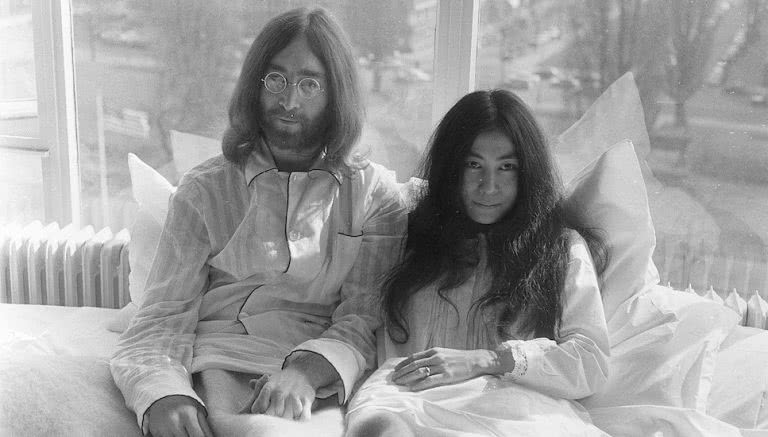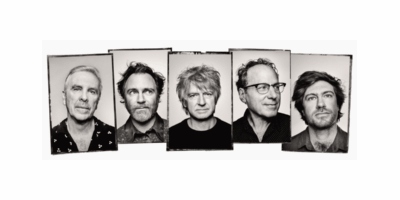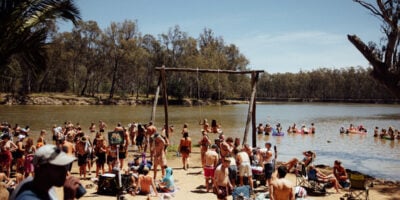What makes a power couple? The aim of this series is to draw attention to two individuals who made significant contributions to popular music and whose romantic relationship was, for a period of time, a feature of their public identity.
Any discussion of an artist’s romantic life will verge on gossipy, but this series isn’t about picking apart a couple’s sex life or their relationship’s internal power dynamic. It’s about highlighting how the love between two culturally impactful artists influenced the work they produced.
Music’s great power couples pt. 1: Yoko Ono and John Lennon
Yoko Ono and John Lennon met in the mid-1960s. John was one of the biggest celebrities on the planet – The Beatles had already released seven studio albums and stacked up 16 #1 singles. With their most recent album, Revolver, the group was also beginning to reveal its commitment to expanding the rock’n’roll idiom.
But Yoko hadn’t been paying much attention to John’s career to date. Seven years his senior, Yoko was affiliated with the New York art collective Fluxus and had already gone a long way towards making an imprint as a post-Dadaist visual, performance and conceptual artist.
Yoko met John in December 1966 when he attended her show at London’s Indica Gallery. While not overly enthusiastic, Lennon was moved by Yoko’s conceptual artwork Ceiling Painting/Yes Painting. The installation involved climbing up a ladder to view a note through a spyglass, which displayed just one word: “Yes.”
The work’s to-the-point optimism was not only indicative of Yoko’s artistic ethos, but also the attitude that’d infuse many of Yoko and John’s collaborative works over the next decade and a half.
Check out ‘The Ballad of John and Yoko’ by The Beatles:

Love Music?
Get your daily dose of metal, rock, indie, pop, and everything else in between.
The story’s been told umpteen times – and is most entertainingly conveyed via The Beatles’ ‘The Ballad of John and Yoko’ – but here’s a quick breakdown of what happened next. John and Yoko entered into a relationship, despite both being married already. They didn’t wait to file divorce papers before making their relationship public, however, and were near inseparable during the last few years of the Beatles’ existence.
Yoko appears prominently in the 1970 documentary film Let It Be, which captures the Beatles workshopping a number of songs for the film’s soundtrack and their final studio album proper, Abbey Road. Yoko also featured on 1968’s The Beatles (aka The White Album), but she was no mere hanger on.
Along with continuing to expand her own artistry, Yoko was introducing John to a range of experimental artistic practices, giving rise to the albums Two Virgins (1968), Life With the Lions and The Wedding Album (both 1969), all of which were avant-garde experimental recordings.
Yoko and John’s first pop music collaboration was the 1969 single ‘Give Peace a Chance’, which was recorded on a four-track tape recorder during their bed-in for peace at the Queen Elizabeth Hotel in Montreal, backed by a quasi-choir of celebrities and journalists. It was the first official single released by a Beatles member without the rest of the group and it went to #2 in the UK singles chart.
Yoko and John released a few more peace-oriented singles over the next few years, namely 1971’s ‘Power to the People’ and ‘Happy Xmas (War Is Over)’, as well as some more pointed political music, most notably 1972’s Some Time in New York City, which bore the influence of radical left wing politics.
Check out ‘Open Your Box’ by Yoko Ono/Plastic Ono Band:

However, the real gold can be found on John and Yoko’s respective solo albums released in the early 1970s. They each released an album named Plastic Ono Band in 1970, with John’s iteration containing his most unvarnished collection of songs to date. Ono’s was similarly raw, but showed no inclination towards pop success.
Yoko was central to the creation of John’s best-known solo release, 1971’s Imagine, and towards the end of his life John gave Yoko credit for the title track’s concept and lyrics. Yoko followed Plastic Ono Band with a trio of masterworks – Fly (1971), Approximately Infinite Universe (1973) and Feeling the Space (1973) – on which she gradually reined in her avant-garde impulses to reveal fierce ingenuity as a songwriter and lead vocalist. John had a hand in all three, appearing as a producer and contributing musician.
Yoko and John split-up in 1973 and stayed apart for 18 months, a period popularly described as John’s “lost weekend”. But after rekindling their love, Yoko gave birth to the couple’s son, Sean Ono Lennon, in October 1975. They didn’t release any new music until 1980’s Double Fantasy, the strength of which suggested their collaborative synergy had never been stronger.
I have no scruples declaring Double Fantasy one of the finest records in John Lennon’s career back catalogue. That’s got a lot to do with how wonderfully his and Yoko’s songs entwine and feed off one another. By this stage, the pair’s political urgency had been replaced by a tender emotionality, which brought us such delicate beauties as ‘Beautiful Boy’ and ‘Woman’, as well as the hair-raising experimental pop numbers ‘Kiss Kiss Kiss’ and ‘Give Me Something’.
They were working on a follow-up to Double Fantasy at the time of John’s murder in December 1980, which formed the bulk of the posthumously released Milk and Honey (1984). You can only imagine what another decade of collaboration might’ve begat, but we should be grateful for the wondrous body of work Yoko and John created, both together and apart.
Check out ‘Oh Yoko’ by John Lennon:


































